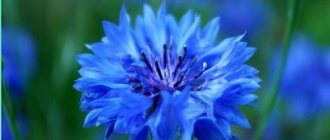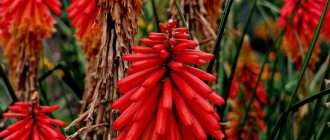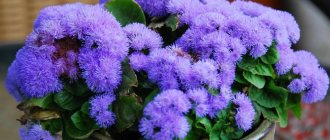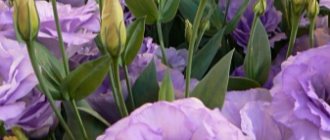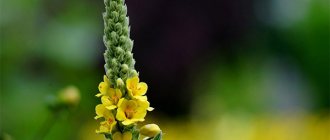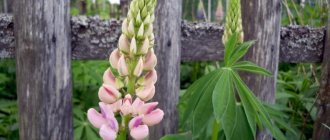Author: Elena N. https://floristics.info/ru/index.php?option=com_contact&view=contact&id=19 Category: Garden plants Published: January 29, 2019Last edits: November 03, 2020
- When to plant
- Growing conditions
- How and when to collect seeds
- Zinnia elegans
Zinnia (lat. Zinnia) belongs to the genus of herbaceous and shrubby perennials of the Asteraceae family, native to Southern Mexico, which received its name in honor of the pharmacologist and botanist Johann Gottfried Zinn from Göttingen, who, as director of the botanical garden, supplied Carl Linnaeus with herbarium material for research. The Aztecs cultivated zinnia since 1500, and it appeared in Europe in the 18th century, immediately becoming a favorite decoration for gardens and aristocratic receptions. By the twentieth century, zinnia was already cultivated on all continents, and from 1931 to 1957, the zinnia flower was even a symbol of the state of Indiana, USA. Today, about twenty species are known, many varieties and hybrids of this beautiful flower, distinguished by its beauty and undemanding conditions for growing.
Planting and caring for zinnia
- Planting: sowing seeds for seedlings - at the end of March or early April, transplanting seedlings into the ground - from mid to late May.
- Flowering: from mid-June until frost.
- Lighting: bright sunlight.
- Soil: light, nutritious, well-drained, neutral reaction.
- Watering: infrequent, but plentiful, at the root.
- Feeding: during the seedling period - three times with mineral fertilizers with low nitrogen content, after transplanting into the ground - at least twice: a month after planting and during the budding period.
- Reproduction: seed.
- Pests: May beetles and beetles, aphids, slugs and snails.
- Diseases: powdery mildew, fusarium, bacterial spot, gray rot.
Read more about growing zinnia below.
Planting zinnias
The plant is heat-loving and does not tolerate frost well; only some selected varieties can withstand sub-zero temperatures.
Zinnias are grown from seedlings. It is kept at home or in a greenhouse until the end of return frosts. Sowing of seeds is carried out in March or April; it is convenient to sow zinnia in individual cups or peat tablets. The soil is purchased ready-made, universal or for tomatoes. The soil is made independently by mixing turf soil, river sand and humus in equal proportions.
Before planting, the seeds are checked for germination; sprouts appear within five days. Planting dates are selected according to the lunar calendar. The most convenient way to use peat tablets is to soak them without removing the reinforcing mesh. For planting zinnias, choose tablets with a diameter of 4 cm. In second place for convenience are individual cups; you can purchase cylindrical blister cups of 6–8 pieces. Deepen the seeds to a depth of 0.5–1 cm. When planting in groups, maintain an interval of at least 4 cm between plants. To ensure rapid emergence of zinnia seedlings, tropical conditions are created: the planting containers are well watered, covered with film, put in a warm place, the recommended germination temperature is +25...+27 °C.
Shoots appear in 5–7 days. The film is removed and the seedlings are transferred to a warm, illuminated place.
Botanical description
Depending on the type and variety, the height of zinnia can be from 20 to 100 cm and above. The leaves of zinnia are entire, sessile, ovate, pointed towards the apex, pubescent with stiff hairs, arranged whorled or opposite. The inflorescences are apical single baskets with a diameter of three to fourteen centimeters, located on long peduncles. Reed zinnia flowers, arranged tiledly in one or several rows, white, purple, orange, yellow, red - all possible colors, except shades of blue; middle, tubular flowers are small, yellow or red-brown. The fruit is an achene with a tuft. Zinnia blooms from mid-June until frost, being resistant to heat and drought.
The zinnia plant is cultivated as a bright and unpretentious garden plant that stands well as a cut flower. Perennial zinnia grows only in areas with warm winters. In our climate, zinnia in the garden is exclusively an annual plant, since it is not able to survive even short and minor frosts. Summer residents call this flower major. Annual zinnias and marigolds, daisies and marigolds are the main flowers for the rustic-style landscape, which is increasingly becoming fashionable in Europe. Zinnia is also appropriate in a flower bed with so-called noble flowers; it is also grown in the garden among vegetables, using its remarkable ability to stretch upward, creating almost no shadow.
Growing zinnia from seeds
How to sow seeds
Perennial zinnia, like annual zinnia, reproduces generatively. In places with a warm climate, where there are no frosts in May, it is possible to plant zinnia directly in the ground, but if night frosts are common in your area, be aware that zinnia seeds sown in the ground will die at a temperature of -1 ºC. That is why experienced gardeners believe that it is better to grow and harden this plant as seedlings, and then planting zinnia in the ground and subsequent rooting will be successful.
- Sweet tobacco: growing from seeds, planting and care
Before sowing, wrap zinnia seeds in a cloth or gauze soaked in epin to determine which ones are viable and which are not. Fresh seeds hatch within a couple of days, while old ones will take a week to sprout.
At the end of March or beginning of April, germinating seeds of two or three pieces are sown generously to a depth of one centimeter in peat pots with a moist substrate, which will subsequently avoid picking, which this crop does not like. The crops are moistened and placed in a bright place. The optimal temperature for germination of zinnia is 22-24 ºC. If you do everything correctly, sprouts will appear within a few days.
In the photo: How zinnia blooms
Seedling care
Young plants quickly form adventitious roots, and if the zinnia seedlings have stretched out, just add a little soil to the pots. My zinnias did not grow very tall, but a friend complained that she put the crops in partial shade, and the seedlings turned into sickly translucent sprouts, so remember that zinnia seedlings require bright, indirect light. If the seeds are sparsely sown, you will not have to pick the seedlings, especially since zinnia does not tolerate picking well. At the end of May, in order for the planting of zinnia to be successful, the seedlings begin to be hardened by taking them out into the fresh air for a while during the day.
How to collect zinnia seeds
To collect zinnia seeds, choose the most beautiful flower and, when it withers and ripens, cut it. The seeds are completely ready no earlier than 60 days, so the material is chosen from the first ones grown in the flowerbed. At the same time, they are also guided by the fact that early flowers are the brightest and largest. That is, some selection work is carried out - the best specimens are selected for reproduction.
If the seed head is not dry enough, you can let it sit longer. It should be brown in color. To extract the seeds, carefully remove the petals and remove the seed from the center of the basket. Then follows sorting, additional drying and packaging in paper bags. You can still sort, but this is relevant if you decide to propagate and use only one type of zinnia for growing.
You can see what zinnia seeds look like in the photo:
Store seeds in a cool, dark place. The main thing is to ensure that mold does not form and to avoid fungal infections.
Planting zinnia in open ground
When to plant
When to plant zinnias in open ground , or rather, when can you plant zinnia seedlings? Zinnia is planted in the ground in the second half of May, towards the end of the month, when the danger of return frosts has passed. The plant prefers bright areas, protected from the wind, with neutral, well-drained, nutritious soil. Before planting zinnia, the intended area is cleared of weeds by digging the soil to a depth of 45 centimeters and adding leaf humus, compost or rotted manure to it while digging at the rate of 8-10 kg per m², and it is best to do this in the fall.
How to plant
Zinnia flowers are planted at a distance of 30-35 cm of one specimen from another by transshipment or together with a peat pot. You will see zinnia blooming in early July.
Reproduction methods
Zinnia is grown both by seedlings and by direct sowing in open ground (in the southern regions). Of course, if a gardener wants to get early flowering of zinnias, they resort to the seedling method.
Propagation of zinnia by seedlings
Sowing of seedlings is carried out in early March in the usual soil for summer growers. It is important to learn how to grow healthy seedlings. Zinnia grows and develops quickly, so if you sow the seeds too early, the seedlings will stretch out, and then it will be difficult to plant them in a permanent place.
For sowing, a substrate is used: garden soil, peat and sand (1: 2: 0.5). The soil is disinfected so that the seedlings are not damaged by the black leg (roasted in the oven or watered with a solution of potassium permanganate).
Before sowing, it is important to disinfect seedling containers (even new ones) in a solution of bleach or copper sulfate.
Low temperature (approximately +15°C) is optimal for seedlings. It is important to consider the sowing depth: it should be equal to three times the thickness of the seed. The seedlings are planted in boxes after the formation of two pairs of true leaves. This is done extremely carefully so as not to damage the roots. And then they are grown in a light greenhouse at a temperature of +18...+20°C.
Plants are planted in an unprotected place when the weather is warm without frost. “Mexican fireworks” does not tolerate temperatures below 0°C; even short-term frosts will destroy this plant variety.
Zinnia develops better on loose, permeable soils, requires heat and sun, and is drought-resistant. Majors are planted avoiding dense plantings to ensure breathability. In the southern regions, seedlings are planted in April-May at a distance of 40-30 cm for tall varieties and 15 cm for short ones. Moisturize as needed.
Drought-resistant zinnia tolerates a lack of moisture more easily than its excess.
If you feed zinnia regularly, it will bloom from June to September-October.
This crop is grown both in a greenhouse to achieve early flowering and in late autumn. Low, early-blooming varieties are suitable for forcing.
Propagation of zinnia by seeds
Zinnia also reproduces by seeds. Gardeners living in areas with a warm, mild climate plant the seeds directly into the flower garden.
Zinnia seeds are selected. They are wrapped in damp gauze and waited for several days. Quality seeds germinate. Then they prepare a place for planting, dig up the ground, and make grooves. Seeds of different varieties are sown in separate containers to avoid confusion. Seeds are sown in them and covered with a layer of sand. The top of the crops is covered with film to form a greenhouse.
The favorable temperature regime for successful seed germination is about +20...+23°C.
During the period of mass flowering, strong plants are chosen to obtain seeds. After drying, the inflorescences are threshed and cleaned. Germination persists for 3-4 years. In a city apartment, packets of seeds are placed in a glass jar with a lid or stored in a closed plastic bag. It is best to place containers with seed on the windowsill, closer to the glass.
When growing seedlings, gardeners cut the best sprouts with nail scissors rather than pulling them out. The slightest damage to the roots will lead to trouble.
It is important to remember that zinnia is a cross-pollinated plant, so to obtain seeds, spatial isolation between varieties of at least 200 meters is necessary.
Zinnia care
Growing conditions
If planting the zinnia was successful, you can talk about caring for it, which consists of regularly loosening the soil, weeding and infrequent but abundant watering at the root so that water does not fall on the flowers. When zinnia begins to bloom, remove faded flowers in a timely manner. The powerful stems of zinnia do not need tying or support.
When to plant chrysanthemums to get lush blooms
Fertilizer
From the moment the seedlings emerge until the time when the zinnia is planted in the ground, the seedlings are fed with mineral fertilizers with a low nitrogen content three times. A plant planted in the ground is fertilized with mineral fertilizers or liquid manure at least twice during the summer: the first time a month after planting, and the second time during the budding period. That's all the trouble. As you can see, planting and caring for zinnia is not at all burdensome.
How to pinch
Readers often ask whether they pinch zinnias and, if so, how and when to do it. If you want the zinnia to bush, you need to pinch it above the third or fourth pair of leaves while still in seedlings, although you can do this when the zinnias in the open ground have already taken root and taken root. But if you want to grow elegant flowers on long stalks for cutting, pinching zinnias is not necessary.
In the photo: Variegated zinnia
Pests and their control
The most common pests that bother zinnia are aphids, chafers, snails and slugs.
Gastropods are usually lured by beer bowls placed here and there around the site, or pieces of slate or roofing felt scattered between plants, under which mollusks like to crawl. You will have to collect them manually.
May beetles will also have to be collected by hand and thrown into a bucket of soapy water. Aphids are destroyed by spraying zinnias with a solution of tar soap at the rate of 10 g per liter of water, and in case of severe infestation - with a solution of Fufanon or Actellik, prepared in accordance with the instructions.
Diseases and their treatment
Among the diseases, it is possible for zinnia to become infected with gray rot, fusarium, bacterial spot, but most often - powdery mildew. If at least one zinnia leaf is disfigured by gray-brown round spots left on the plant by bacterial spotting, take immediate action: tear off the leaves that have traces of the disease, and in case of severe infection, destroy the entire plant - there is no cure for this disease.
- How to plant delphinium
Gray mold and fusarium are treated with fungicides (Topsin-M, Fundazol), as well as powdery mildew, which appears as a white coating on the above-ground parts of zinnia - Topaz, Skor, Topsin are more suitable among fungicides to get rid of this scourge.
It must be said that diseases arise primarily due to violations of the rules for growing the plant, for example, due to too thick planting or excessive watering, so first diagnose the zinnia problem, eliminate it, if possible, and then work on the mistakes - re-read rules for plant care, find and analyze the discrepancy between them and how things really are. This is the only way you can avoid troubles in the future.
In the photo: Dense zinnia bushes
How to care
Zinnia does not require complex care. For its successful growth, it is necessary to remove weeds, loosen the soil, and water without getting on the buds themselves. Let's look at the care recommendations in more detail.
Soil selection
Before planting zinnia in the ground, you need to check the composition of the soil. It should contain a lot of humus, nutrients and be well drained. To achieve greater looseness, it is recommended to dilute the soil with expanded clay and vermiculite.
Location and lighting
Zinnia flowers need sunlight. For this reason, it is recommended to select an area that has good lighting and is protected from draft winds. Since this plant develops better in drained soil, elevated areas will be suitable for planting this representative of the flora.
Temperature, humidity, watering
Zinnia is drought tolerant. For this reason, watering should be carried out when there is no natural precipitation for a long time, but it should be done abundantly. During this procedure, it is very important to ensure that water does not get on the buds, otherwise they will begin to lose their decorative effect and rot. By following these recommendations, the flower will be healthy and beautiful throughout the season.
Fertilizers and fertilizers
Before planting the plant, it is necessary to fertilize the soil with superphosphate and potassium sulfate. In order for the nutrients to act more actively, it is better to use the formulations in liquid form. But fresh organic matter cannot be used, otherwise the zinnia will become weak and be affected by powdery mildew.
Transfer
You can transplant to a permanent site with the onset of the first summer month, when the frosts have passed. After this, it is important to water the plant, otherwise its inflorescences will be scanty.
Trimming
By regularly removing buds that have already bloomed, zinnia will have the strength to bloom more actively.
Zinnia after flowering
How and when to collect seeds
Zinnia seeds ripen about two months after flowering begins, so mark a few of the first ones to open. Shoots of the first order have the best quality seeds, so you should remove all side shoots from the specimens you have chosen for seed ripening. When the ripe baskets turn brown, they are cut off, dried, the seeds are removed, cleaned of dry remains of flowers and stored in a dry place at a constant temperature. Zinnia seeds remain viable for 3-4 years.
On the picture:
Perennial zinnia in winter
As has been mentioned more than once, zinnia is grown in the garden as an annual plant. But if your zinnia does not grow in open ground, but in a container or pot, then with the onset of autumn, bring the flower indoors and care for it like a houseplant, turning it from an annual zinnia into a perennial one.
Features of growing zinnias
During the period of active growth of seedlings, fertilize with Agricola complex fertilizer for indoor plants. When general planting of seeds in a large container, plant picking is carried out after the appearance of the third full-fledged leaf.
The optimal growth temperature is not higher than +22…+24 °C, not lower than +17 °C. If the seedlings are very stretchy, they are given additional light, increasing the daylight hours to 14 hours. The plant blooms 2.5 months after the sprouts appear; seedlings are transplanted at the age of 4 to 6 weeks. During the growth process, lateral shoots are pinched and the top of the stem is removed. You can cut it with scissors; they are pre-disinfected.
Fertilizing during the growing season is carried out no more than once a month. It is advisable to choose complex ones, which include potassium, calcium, and phosphorus. Nitrogen fertilizers are applied in a limited manner so as not to provoke root rot. For feeding, superphosphate, ammophosphate, potassium sulfate, and ready-made fertilizers “Flower” and “Rainbow” are used. Before planting in the ground, the seedlings are hardened off - taken out to a cool place, allowed to spend the night in the open air, first under a fabric cover, then without it.
Types and varieties
Of the more than twenty species of zinnia, only four are grown in culture: graceful zinnia, narrow-leaved zinnia, also known as Hage zinnia, thin-flowered zinnia and zinnia linearis. The first two species served as the basis for fruitful breeding work, and, thanks to its results, today we cultivate in our gardens not only the main types of zinnia, but also many beautiful varieties and hybrids of this plant.
Zinnia elegans
Herbaceous annual up to 1 meter high and higher with simple white, orange and pink inflorescences. The stem is straight, mostly unbranched, round in cross-section, densely pubescent with hard hairs; all shoots end in apical inflorescences-baskets. The leaves are sessile, entire, ovate, with a pointed apex, 5-7 cm long and 3-4.5 cm wide, the surface of the leaf is pubescent, like the stem. Inflorescences with a diameter of 5 to 16 cm, simple, semi-double and double, consist of reed flowers up to 4 cm long and up to 1.5 cm wide, painted in all kinds of colors, except shades of blue, and median, tubular flowers of yellow or reddish-brown color .
Types and varieties of celosia - an amazingly beautiful flower
Graceful zinnia blooms in June and can bloom until the coldest weather. In nature, it is most common in southern Mexico. In culture since 1796. Varieties and hybrids of graceful zinnia are classified according to several characteristics: by the structure of the inflorescences, by their shape, by the height of the stem and by the timing of flowering.
In the photo: Elegant zinnia (Zinnia elegans)
According to the timing of flowering, there are early-blooming, mid-blooming and late-blooming zinnias.
According to the structure of the inflorescences, varieties are divided into simple, semi-double and double.
Depending on the height of the stem, it happens:
- tall zinnia (60-90 cm), grown for cutting, since it looks somewhat bulky in a flowerbed;
- medium zinnia (35-50 cm) – suitable both for cutting and for decorating flower beds;
- Dwarf zinnia, or low-growing zinnia (15-30 cm) - usually these are well-branched bushes, grown both in flower beds and in balcony containers and simply in pots.
In the photo: Elegant zinnia (Zinnia elegans)
Zinnias are divided into seven categories based on the shape of their inflorescences. In our climate, the most commonly grown of these are:
- Zinnia dahlia - powerful bushes, spreading or compact, 60 to 90 cm high with shoots of the first order. The leaves are large - up to 12 cm long, the inflorescences are hemispherical, double, up to 14 cm in diameter. Varieties: Violet - terry zinnia 60-75 cm tall with dense inflorescences of different shades of purple, Orange Koenig - on stems 60 to 70 cm high, bright red-orange double inflorescences up to 14 cm in diameter, Polar Bear - a compact plant up to 65 cm high cm with densely double white inflorescences with a greenish tint;
- Lilliputian zinnia, or pompon zinnia, is a compact branched bush no higher than 55 cm with a large number of shoots of the second, third and fourth order, small leaves and small inflorescences, only up to 5 cm in diameter, resembling a pom-pom on a hat. Varieties: Red Riding Hood - a densely double variety up to 55 cm high with truncated-cone-shaped or rounded inflorescences of a bright red hue; Tom Thumb is a compact bush up to 45 cm in height with dense double red inflorescences in the shape of a slightly flattened ball; Tambelina is a variety mixture of different shades with a bush height of up to 45 cm and inflorescence diameter from 4 to 6 cm;
- zinnia fantasy - almost spherical compact bushes 50-65 cm high with large leaves and loose curly inflorescences, in which narrow reed flowers are rolled into tubes and curved in different directions, and at the ends some of them are forked. Varieties: Fantasy - a bush up to 60 cm high with double loose inflorescences up to 10 cm in diameter in different shades - purple, red, bright yellow, purple, red-orange, pink, white, salmon, etc.; The gift is a bright red zinnia.
In the photo: Elegant zinnia (Zinnia elegans)
Also popular in the culture of other countries:
- Californian giant zinnia - varieties of double zinnias with a diameter of up to 16 cm with imbricated reed flowers and a stem height of up to 1 meter or more. They differ in relatively late flowering;
- giant cactus zinnia - varieties ranging in height from 75 to 90 cm with double inflorescences up to 11 cm in diameter with reed flowers rolled into a tube, sometimes wavy with raised tips;
- zinnia supercactus - varieties with the same inflorescences as those of giant cacti, but no more than 60 cm in height;
- zinnia scabiosa (also anemone-flowered) - varieties with an inflorescence up to 8 cm in diameter, in which reed flowers are arranged in one row around the middle, consisting of tubular flowers overgrown with corollas, which makes the middle look like a hemisphere, colored to match the reed flowers.
In the photo: Elegant zinnia (Zinnia elegans)
Zinnia angustifolia
Or Zinnia haageana - also native to Mexico. This is an annual erect plant that forms branched bushes. The leaves are sessile, lanceolate or elongated, pointed. The inflorescences are small, simple or double, bright orange. Varieties:
- The 7 most important things to do in the garden in the fall - how to prepare the garden for winter
- Glorienshain is a highly branched bush up to 25 cm tall with double inflorescences, in which the reed flowers are dark orange at the base and red-brown at the ends;
- Persian Carpet Mixed series with semi-double bicolor inflorescences of red with lemon, white, orange and yellow - a large mass of this zinnia really looks like an oriental carpet.
- variety mixtures Starbright and Classic have also become famous - plants with inflorescences of white, yellow and orange tones up to 30 cm in height with a thin and weak, but highly branched creeping stem. These zinnias are mostly used as ground cover plants.
- Zinnias of the Sombrero variety look nice in a flower bed - inflorescences of a red-brown hue with an orange border.
In the photo: Zinnia angustifolia
Zinnia tenuiflora
It is usually used to create landscape flower beds and consists of bushes about 60 cm high with angled thin stems of a reddish hue. The inflorescences are small, up to 3 cm in diameter, the reed flowers are narrow, bent, with curled tips, of a purple hue. Varieties: Red Spider.
Zinnia linearis
It is sometimes confused with angustifolia zinnia because its leaves are thin and sharp, like the ends of nail scissors. This is the smallest of the cultivated species - branching, almost spherical bushes grow no higher than 35 cm. Linearis inflorescences are small, reed flowers of yellow color with an orange edge. Zinnia linearis is suitable for growing in pots, in balcony containers, on alpine hills and in small flower beds. Varieties:
- Golden eye - white center of tubular flowers, reed flowers are white - the variety is similar to an ordinary chamomile;
- Caramel – the color of the reed flowers is caramel yellow, the center is black;
- Yellow Star is a variety with yellow inflorescences.
In the photo: Zinnia linearis
From crossing the Haage zinnia and the graceful zinnia, many hybrids were bred, in particular, the Proffusion series, which is very popular among gardeners - low bushes up to 35 cm, strewn with small multi-colored daisies. The Magellan series is also gaining popularity - bushes up to 35 cm tall with densely double dahlia-shaped inflorescences with a diameter of up to 10 cm in coral, cream, orange, pink, red, cherry, salmon and yellow colors. The Swizzle series has recently appeared in gardens, consisting so far of two varieties - Cherry Ivory with cherry baskets with cream tips of reed flowers and Scarlett Yellow with red inflorescences and bright yellow tips.


